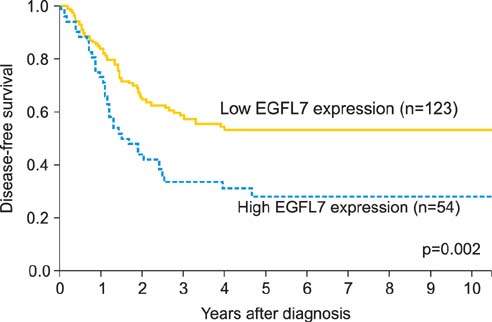J Gynecol Oncol.
2014 Oct;25(4):334-341. 10.3802/jgo.2014.25.4.334.
High expression of epidermal growth factor-like domain 7 is correlated with poor differentiation and poor prognosis in patients with epithelial ovarian cancer
- Affiliations
-
- 1Department of Obstetrics and Gynecology, Catholic University of Daegu, School of Medicine, Daegu, Korea. drcys@cu.ac.kr
- 2Department of Pathology, Catholic University of Daegu, School of Medicine, Daegu, Korea.
- 3Department of Molecular Biology, Kyung Hee University College of Pharmacy, Seoul, Korea.
- 4Department of Life and Nanopharmaceutical Sciences, Kyung Hee University, Seoul, Korea.
- KMID: 2130123
- DOI: http://doi.org/10.3802/jgo.2014.25.4.334
Abstract
OBJECTIVE
The purpose of this study was to evaluate the expression of epidermal growth factor-like domain 7 (EGFL7) in epithelial ovarian cancer, and to assess its relevance to clinicopathological characteristics and patients' survival.
METHODS
A total of 177 patients with epithelial ovarian cancer were enrolled in the current study. For each patient, a retrospective review of medical records was conducted. Immunohistochemical staining for EGFL7 was performed using tissue microarrays made with paraffin-embedded tissue block. EGFL7 expression levels were graded on a grade of 0 to 3 based on the percentage of positive cancer cells. We analyzed the correlations between the expression of EGFL7 and various clinical parameters, and also analyzed the survival outcome according to the EGFL7 expression.
RESULTS
The expression of EGFL7 in ovarian cancer tissues was observed in 98 patients (55.4%). High expression of EGFL7 (grade 2 or 3) was significantly correlated with pathologic type, differentiation, stage, residual tumor after debulking surgery, lymphovascular space involvement, lymph node metastasis, high cancer antigen 125, peritoneal cytology, and ascites. Among these clinicopathologic factors, differentiation was significantly correlated with EGFL7 expression in multivariate analysis (p<0.05). Survival analysis showed that the patients with high EGFL7 expression had a poorer disease free survival than those with low EGFL7 expression (p=0.002).
CONCLUSION
Our data suggest that EGFL7 expression is a novel predictive factor for the clinical progression of epithelial ovarian cancer, and may constitute a therapeutic target for antiangiogenesis therapy in patients with epithelial ovarian cancer.
Keyword
MeSH Terms
-
Adult
CA-125 Antigen/blood
Cell Differentiation/physiology
Endothelial Growth Factors/*metabolism
Female
Humans
Lymphatic Metastasis
Middle Aged
Neoplasm Proteins/metabolism
Neoplasm Staging
Neoplasm, Residual
Neoplasms, Glandular and Epithelial/*diagnosis/pathology/surgery
Ovarian Neoplasms/*diagnosis/pathology/surgery
Prognosis
Retrospective Studies
Survival Analysis
Tumor Markers, Biological/*metabolism
CA-125 Antigen
Endothelial Growth Factors
Neoplasm Proteins
Tumor Markers, Biological
Figure
Cited by 1 articles
-
EGFL7 expression profile in IDH-wildtype glioblastomas is associated with poor patient outcome
Bruno Henrique Bressan da Costa, Aline Paixão Becker, Luciano Neder, Paola Gyuliane Gonçalves, Cristiane de Oliveira, Allan Dias Polverini, Carlos Afonso Clara, Gustavo Ramos Teixeira, Rui Manuel Reis, Lucas Tadeu Bidinotto
J Pathol Transl Med. 2022;56(4):205-211. doi: 10.4132/jptm.2022.04.22.
Reference
-
1. Park B, Park S, Kim TJ, Ma SH, Kim BG, Kim YM, et al. Epidemiological characteristics of ovarian cancer in Korea. J Gynecol Oncol. 2010; 21:241–247.2. Li JJ, Yang XM, Wang SH, Tang QL. Prognostic role of epidermal growth factor-like domain 7 protein expression in laryngeal squamous cell carcinoma. J Laryngol Otol. 2011; 125:1152–1157.3. Huang CH, Li XJ, Zhou YZ, Luo Y, Li C, Yuan XR. Expression and clinical significance of EGFL7 in malignant glioma. J Cancer Res Clin Oncol. 2010; 136:1737–1743.4. Wu F, Yang LY, Li YF, Ou DP, Chen DP, Fan C. Novel role for epidermal growth factor-like domain 7 in metastasis of human hepatocellular carcinoma. Hepatology. 2009; 50:1839–1850.5. Fan C, Yang LY, Wu F, Tao YM, Liu LS, Zhang JF, et al. The expression of Egfl7 in human normal tissues and epithelial tumors. Int J Biol Markers. 2013; 28:71–83.6. Diaz R, Silva J, Garcia JM, Lorenzo Y, Garcia V, Pena C, et al. Deregulated expression of miR-106a predicts survival in human colon cancer patients. Genes Chromosomes Cancer. 2008; 47:794–802.7. Sun Y, Bai Y, Zhang F, Wang Y, Guo Y, Guo L. miR-126 inhibits non-small cell lung cancer cells proliferation by targeting EGFL7. Biochem Biophys Res Commun. 2010; 391:1483–1489.8. Delfortrie S, Pinte S, Mattot V, Samson C, Villain G, Caetano B, et al. Egfl7 promotes tumor escape from immunity by repressing endothelial cell activation. Cancer Res. 2011; 71:7176–7186.9. Nomura H, Tamada Y, Miyagi T, Suzuki A, Taira M, Suzuki N, et al. Expression of NEU3 (plasma membrane-associated sialidase) in clear cell adenocarcinoma of the ovary: its relationship with T factor of pTNM classification. Oncol Res. 2006; 16:289–297.10. Nichol D, Stuhlmann H. EGFL7: a unique angiogenic signaling factor in vascular development and disease. Blood. 2012; 119:1345–1352.11. Meister J, Schmidt MH. miR-126 and miR-126*: new players in cancer. ScientificWorldJournal. 2010; 10:2090–2100.12. Soncin F, Mattot V, Lionneton F, Spruyt N, Lepretre F, Begue A, et al. VE-statin, an endothelial repressor of smooth muscle cell migration. EMBO J. 2003; 22:5700–5711.13. Nikolic I, Plate KH, Schmidt MH. EGFL7 meets miRNA-126: an angiogenesis alliance. J Angiogenes Res. 2010; 2:9.14. Campagnolo L, Moscatelli I, Pellegrini M, Siracusa G, Stuhlmann H. Expression of EGFL7 in primordial germ cells and in adult ovaries and testes. Gene Expr Patterns. 2008; 8:389–396.15. Philippin-Lauridant G, Baranzelli MC, Samson C, Fournier C, Pinte S, Mattot V, et al. Expression of Egfl7 correlates with low-grade invasive lesions in human breast cancer. Int J Oncol. 2013; 42:1367–1375.16. Johnson L, Huseni M, Smyczek T, Lima A, Yeung S, Cheng JH, et al. Anti-EGFL7 antibodies enhance stress-induced endothelial cell death and anti-VEGF efficacy. J Clin Invest. 2013; 123:3997–4009.
- Full Text Links
- Actions
-
Cited
- CITED
-
- Close
- Share
- Similar articles
-
- The Expression of c-erbB-2, EGFR, p53 and Ki-67 in Ovarian Borderline Tumors and Carcinomas of the Ovary
- Correlation of epidermal growth factor receptor expression with prognostic factors in patients with ovarian neoplasms
- Overexpression of HER2/HER3 and clinical feature of ovarian cancer
- The expression of Thymosin beta4 with angiogenic factors in epithelial ovarian cancer
- Prognostic significance of epidermal growth factor receptor expression in human gastric carcinoma



